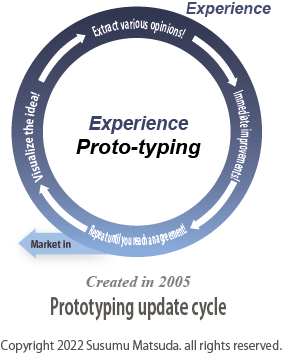This time, I would like to introduce in all eight episodes various development methods such as the prototype development cycle that we have been working on through 20 years of product development, the cycle that creates new safety methods, and the cycle that enhances safety and maintains safety processes.
In the case of developing a custom product according to the customer’s request, the hearing work to find out the customer’s image and functional specifications is important. This process, which is carried out first in software development, is the process of formulating and determining specifications in the most important process in advancing development. In particular, software development specifications can be freely defined. I think that any specifications can be realized by expanding the image. While software is an idea game, it seems that it can be realized by responding to any specifications, but there are some items that cannot be technically realized. If the feasibility is not simulated in advance, the development work will be difficult and unrealizable. When development is completed and commercialized software continues to be used, new demands often arise. In order to meet the demand, it is necessary to consider at the time of design so that the demand for function expansion can be met. In software development, it is necessary to anticipate future requirements in advance and to design the program structure in consideration of the extensibility of functions. In product development that involves visual images such as VR, there are cases where the difference in image between the designer and the customer becomes a major issue.

This image is because the image is generated in the brain by the sensibility, and the sensibility is slightly different for each person. In software such as VR, where the senses (visual and auditory) greatly determine how to feel, it is difficult to define the image in sentences, and both sides understand and agree. In many cases, matching the image of the designer and the customer is one of the difficult and big challenges. Images with sensations are deeply related to sensibilities as an element that greatly affects image generation. This sensibility includes the experience of each individual, the process of learning by experiencing things, and the conditions that are recognized by gaining knowledge, and the experiences are different, and it is rare that the sensibilities match. However, the sensibilities are considered to be averagely distributed, and the general image direction is considered to match to some extent. Considering such circumstances, the logical part of the requirement definition of VR software can be defined in sentences, but it is difficult to define the image related to sensibility in sentences, and the method of completely matching the image is to use the image. There is no choice but to present and show it as an image in the development of VR software, it is important to experience and confirm the software each time the development progresses and an image is generated. These confirmations also have influence with the requesting customer. Since the specifications are confirmed for the first time by presenting the image, there are many cases where both images do not match, and no consensus can be obtained, and the work process of matching the images while making many modifications to the program increases. This confirmation method has poor development efficiency, and it involves modifying the software and, in some cases, modifying the program structure, which is a major task and reduces profits. We have improved the efficiency of product development by making consensus while modifying the direction of progress while explaining the final finished image using the unfinished state at an early stage before the design is completed. With this method, we are developing prototypes of more than 120 companies, and it is possible to reach consensus at an early stage.
No tags for this post.No tags for this post.